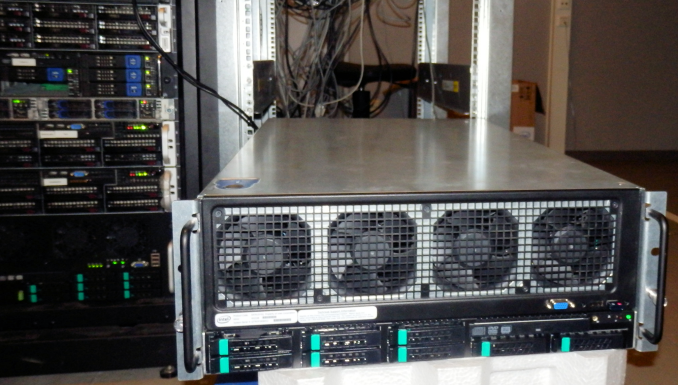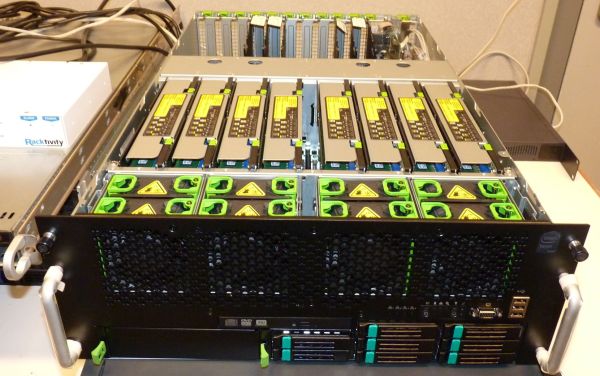The Intel Xeon E7-8800 v3 Review: The POWER8 Killer?
by Johan De Gelas on May 8, 2015 8:00 AM EST- Posted in
- CPUs
- IT Computing
- Intel
- Xeon
- Haswell
- Enterprise
- server
- Enterprise CPUs
- POWER
- POWER8
Benchmark Configuration
As far as reliability is concerned, while we little reason to doubt that the quad Xeon OEM systems out there are the pinnacle of reliability, our initial experience with Xeon E7 v3 has not been as rosy. Our updated and upgraded Quad Xeon Brickland system was only finally stable after many firmware updates, with its issues sorted out just a few hours before the launch of the Xeon E7 v3. Unfortunately this means our time testing the stable Xeon E7 v3 was a bit more limited than we would have liked.
Meanwhile to make the comparison more interesting, we decided to include both the Quad Xeon "Westmere-EX" as well as the "Nehalem-EX". Remember these heavy duty, high RAS servers continue to be used for much longer in the data center than their dual socket counterparts, 5 years or more are no exception. Of course, the comparison would not be complete without the latest dual Xeon 2699 v3 server.
All testing has been done on 64 bit Ubuntu Linux 14.04 (kernel 3.13.0-51, gcc version 4.8.2).
Intel S4TR1SY3Q "Brickland" IVT-EX 4U-server
The latest and greatest from Intel consists of the following components:
| CPU | 4x Xeon E7-8890v3 2.5 GHz 18c, 45 MB L3, 165W TDP or 4x Xeon E7-4890 v2 (D1 stepping) 2.8GHz 15 cores, 37.5MB L3, 155W TDP |
| RAM | 256 GB, 32x 8 GB Micron DDR-4-2100 at 1600MHz or 256 GB, 32x8GB Samsung 8GB DDR3 M393B1K70DH0-YK0 at 1333MHz |
| Motherboard | Intel CRB Baseboard "Thunder Ridge" |
| Chipset | Intel C602J |
| PSU | 2x1200W (2+0) |
Total amount of DIMM slots is 96. When using 64GB LRDIMMs, this server can offer up to 6TB of RAM.
If only two cores are active, the 8890 can boost the clockspeed to 3.3 GHz (AVX code: 3.2 GHz). The 4890v2 reaches 3.4 GHz in that situation. Even with all cores active, 2.9 GHz is possible (AVX code: 2.6 GHz).
Intel Quanta QSCC-4R Benchmark Configuration
The previous quad Xeon E7 server, as reviewed here.
| CPU | 4x Xeon X7560 at 2.26GHz, or 4x Xeon E7-4870 at 2.4GHz |
| RAM | 16x8GB Samsung 8GB DDR3 M393B1K70DH0-YK0 at 1066MHz |
| Motherboard | QCI QSSC-S4R 31S4RMB00B0 |
| Chipset | Intel 7500 |
| BIOS version | QSSC-S4R.QCI.01.00.S012,031420111618 |
| PSU | 4x850W Delta DPS-850FB A S3F E62433-004 850W |
The server can accept up to 64 32GB Load Reduced DIMMs (LR-DIMMs) or 2TB.
Intel's Xeon E5 Server – "Wildcat Pass" (2U Chassis)
Finally, we have our Xeon E5 v3 server:
| CPU | Two Intel Xeon processor E5-2699 v3 (2.3GHz, 18c, 45MB L3, 145W) |
| RAM | 128GB (8x16GB) Samsung M393A2G40DB0 (RDIMM) |
| Internal Disks | 2x Intel MLC SSD710 200GB |
| Motherboard | Intel Server Board Wilcat pass |
| Chipset | Intel Wellsburg B0 |
| BIOS version | August the 9th, 2014 |
| PSU | Delta Electronics 750W DPS-750XB A (80+ Platinum) |
Every server was outfitted with two 200 GB S3700 SSDs.












146 Comments
View All Comments
PowerTrumps - Saturday, May 9, 2015 - link
Oracle has been unable to develop a power core let alone a processor. What they have done is created servers with many cores and many threads albeit weak cores/threads. The S3 core was an improvement and no reason to think the S4 won't be decent either. However, the M7 will come (again, true to form) with 32 cores per socket. It will be like 8 mini clusters of 4 cores because they are unable to develop a single SMP chip with shared resources across all of the cores. As such, these mini clusters will have their own resources which will lead to latency and inefficiencies. Oracle is a software business and their goal is to run software on either the most cores possible or the most inefficient. They have both of these bases covered with their Intel and SPARC business.Also, performance per Watt is important for Intel because what you see is what you get. With Power though, when you have strong single thread performance, strong multi-thread performance and tremendous consolidation efficiency due to Power Hypervisor efficiency means ~200W doesn't matter when you can consolidate 2, 4 maybe 10 Intel chips at 135W each into a single Power chip because of this hypervisor efficiency.
tynopik - Friday, May 8, 2015 - link
pg4 - datam iningder - Friday, May 8, 2015 - link
Woo...we're bout to have another GHz War here!usernametaken76 - Friday, May 8, 2015 - link
I'm sure you mean figuratively. We've been stuck between 4-5 GHz on POWER architecture for closing in on a decade.zamroni - Friday, May 8, 2015 - link
My conclusion is Samsung should buy AMD to reduce Intel dominance.alpha754293 - Friday, May 8, 2015 - link
It would have been interesting to see the LS-DYNA benchmark results again (so that you can compare it against some of the tests that you've ran previously). But very interesting...JohanAnandtech - Friday, May 8, 2015 - link
Give me some help and we'll do that again on an update version :-)alpha754293 - Tuesday, May 12, 2015 - link
Not a problem. You have my email address right? And if not, I'll just send you another email and we can get that going again. :) Thanks.andychow - Friday, May 8, 2015 - link
If Samsung bought AMD, they would lose the licence for both x86 and x86_64 production. It would in fact ensure Intel's dominance of the market.Kevin G - Friday, May 8, 2015 - link
The x86 license can be transferred as long as Intel signs off on the deal (and it is in their best interest to do so). What will probably happen is that if any company buys AMD, the new owner will enter a cross licensing agreement with Intel.